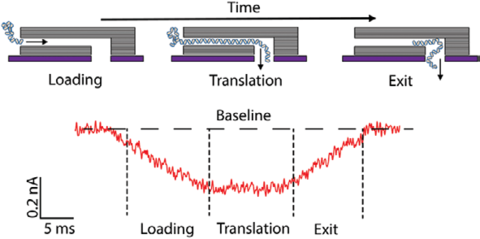Translocation of DNA through Ultrathin Nanoslits

2D nanoslit devices, where two crystals with atomically flat surfaces are separated by only a few nanometers, have attracted considerable attention because their tunable control over the confinement allows for the discovery of unusual transport behavior of gas, water, and ions. Here, the passage of double-stranded DNA molecules is studied through nanoslits fabricated from exfoliated 2D materials, such as graphene or hexagonal boron nitride, and the DNA polymer behavior is examined in this tight confinement. Two types of events are observed in the ionic current: long current blockades that signal DNA translocation and short spikes where DNA enters the slits but withdraws. DNA translocation events exhibit three distinct phases in their current-blockade traces—loading, translation, and exit. Coarse-grained molecular dynamics simulation allows the different polymer configurations of these phases to be identified. DNA molecules, including folds and knots in their polymer structure, are observed to slide through the slits with near-uniform velocity without noticeable frictional interactions of DNA with the confining graphene surfaces. It is anticipated that this new class of 2D-nanoslit devices will provide unique ways to study polymer physics and enable lab-on-a-chip biotechnology.
Simulation of DNA translocation through a nanoslit.
Simulation of DNA translocation through a nanoslit.
Simulation of DNA translocation through a nanoslit.
Simulation of DNA translocation through a nanoslit.
Simulation of DNA translocation through a nanoslit.
Simulation of a "probing" event where the DNA partially enters the nanoslit but does not continue to translocate.